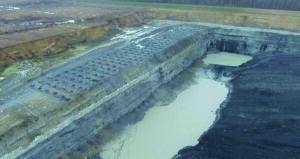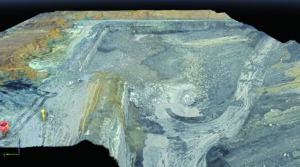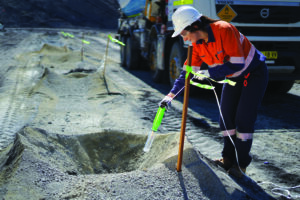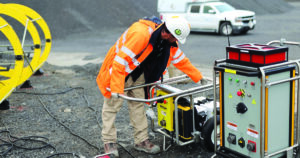
Above, the bench and the six rows used in the pattern designed by DynoConsult. (Photo: DynoConsult)
Two suppliers share data and anecdotes from the field that show how their latest offerings help customers cut costs and improve productivity
By Jesse Morton, Technical Writer
Whenever given a platform, blasting solutions suppliers emphasize the success experienced by allowing collaboration and customer feedback to drive research and development. The resulting offerings typically add value, cut costs, and improve safety. The examples of those benefits being realized are many and prompt announcements of record-setting blasts, incredible efficiency improvements, and perplexing problems solved.
Most recently, Dyno Nobel reported how DynoConsult helped a miner to, among other things, potentially save $500,000 annually on material handling costs. Meanwhile, Orica reported two of its newest technologies have helped multiple Australian operations increase productivity and meet regulations. The suppliers say similar benefits are available to new and established customers, with whom they hope to partner with on solving blasting challenges.
DynoConsult Optimizes Blasting Strategy
Dyno Nobel reported DynoConsult recently helped a coal mine optimize their blasting strategy and reduce overall overburden removal costs. The strategy used could be applied at other mines, a consultant for the supplier said.
The coal miner hired Dyno Nobel’s DynoConsult team to help debunk an underperforming blasting strategy and then find a better one that would reduce overburden removal costs. “The customer and DynoConsult found a cast performance problem and identified it as blast stacking,” said Charles Dammann, field consultant, Dyno Nobel Americas.
“This problem is caused by face material not moving far enough or fast enough, thus impeding the movement of the remainder of the blast material and creating a smaller power trough,” he said. “With customer collaboration, DynoConsult theorized that the reduction of the front row burdens would allow for sufficient movement to prevent it from impacting the back row movement.”
Per the theory, “an extra row was added, and the pattern implemented a variable burden design,” Dammann said. “The burden was lowered on the front three rows and widened on the back three rows to maintain a consistent average powder factor between that of the front and back rows.”
The variable burden design should increase casting performance “because it allows material in the front of the blast to move further into the effective cast zone,” the paper said. “This accompanies an increase in powder factor between the two overburden cuts.”
The supplier had previous success with the strategy, but it was new to the mine site.
The DynoConsult team launched an experiment to compare the results of the new strategy to those of the existing blast design.
“A 140-ft control cut and a 140-ft experimental cut were used to compare cost records and overburden cast blast data collected by the customer and by DynoConsult,” Dyno Nobel said in a white paper. “The primary change between the two overburden cuts was the layout of the drill pattern.”
To compare the results, the DynoConsult team assessed cost and performance data for both the control and experimental cuts.
“The unit costs and material volumes were provided by the customer,” the paper said. Using a drone, DynoConsult collected the performance data.
“The cast data collection process took a few months, but that was limited by the production rates at the site,” Dammann said. “The data collection process involved setting up a drone flight path over the blast, and taking top-down photos of the area before and after the overburden cast is initiated.”
The drone, a DJI Mavic 2 Pro, offers “many advantages in a cast-analysis situation,” he said. It is capable of a 30-minute flight on one battery. “The drone is compatible with many free flight apps, allowing for quick flight path setup and flying.”
The drone was equipped with a high-resolution camera for optimal accuracy in the resulting three-dimensional (3D) mosaics. “The pictures taken by the drone have drone-GPS location data stored in the pictures’ metadata,” Dammann said.
“The photo location measured by the GPS allows a computer program to spatially relate the pictures to each other, then stitch them together in a process called photogrammetry,” he said. “The result is a 3D mosaic of the bench before the blast and the muck pile following the blast.”
For the performance analysis, “the pre-blast and post-blast mosaics are overlayed as contour maps in Carlson AutoCAD,” Dammann said. “The features of this program make volume comparisons quick and easy to set up,” he said. Comparison results were available within 30 minutes.
“The use of a CAD program allows for accurate volume measurements, as opposed to the traditional method of muck profiling,” Dammann said. From the blast geometry, a virgin block and final spoil slope are rendered.
“By comparing the volumes between the virgin block, the muck pile, and the final spoil slope, blast performance is measured,” he said. The results include rock swell, expressed as a percentage.
“The total material cast is the muck material that is cast beyond the toe of the virgin block,” Dammann said. Total cast is expressed in cubic yards and as a percentage of total swelled volume.
“Effective cast is the muck material that was cast to its final location on the spoil slope,” he said. Effective cast is expressed in cubic yards and as a percentage of the total swelled volume.
“The casting volumes and swell are determined for every cast on the bench in question, and that data is sent to the customer and saved in a database by DynoConsult,” Dammann said. “When the customer requested an analysis of cast performance following a planned change in pattern design, the saved data was used to compare the performance of the two cuts.”
The analysis spanned two weeks, “with much of that time spent compiling cost and explosive usage data from the customer’s database,” Dammann said.
The cast performance data showed “improved casting results,” the paper said.

Above, a screenshot of the post-shot 3D mosaic, which was one of the models used in the cast performance analysis. (Image: DynoConsult)
“The total cast increased from 36.7% to 43.7%, and effective cast values increased from 17.4% to 24.9% between the cuts,” the paper said. “The resulting overburden cast increase reduced the amount of work for the bulldozers.”
Extrapolating that out showed the new strategy could “reduce rehandle material by 3,430,000 bank cubic yards,” the paper said.
“This increase in casting volume accounts for much of the 19% decrease in bulldozer hours between the cuts,” it said. “The change in pattern design is projected to save the mine $500,000 annually on direct material movement costs.”
The new strategy would also reduce bulldozer hours, the paper said. “Having bulldozers available for additional work further reduces costs and improves overall efficiency of the mine.”
While the strategy was designed for a specific coal mine, “the changes to the pattern design are not specific to the geology and layout of the mine in question,” Dammann said.
The blast strategy was “shown to improve cast blasting performance at this specific site, but the pattern design itself is not necessarily site-specific,” he said. “The different pattern design could be used at other sites that use cast blasting.”

Released in March, WebGen 200 Surface enables wireless blasting, allowing customers “to optimize their entire mining process,” Orica said. (Photo: Orica)
New Orica Solutions Improve Productivity
Located near a residential area, Bloomfield mine used the 4D bulk explosives delivery system to successfully meet environmental regulations. Managing the environmental effects of blasting, including post blast fume, is crucial to maintaining Bloomfield’s license to operate. Previously, wet conditions and soft ground geology prompted the open-cut operation in the Hunter Valley, New South Wales, Australia, “to charge ANFO patterns with Fortis Coal emulsion at a much higher density,” said Keiran Knowles, senior manager, 4D commercialization. “This pumped emulsion blend has 44% more energy than ANFO,” he said. “In soft ground, the excess energy often caused fume.”
The extra mass of explosive per blasthole and higher unit cost of Fortis directly increased the unit cost of blasting. A solution was required to productively blast soft, wet ground without increasing the powder factor, and without fume.
The mine adopted the 4D system integrated with the BlastIQ suite of digital blast optimization technologies, ensuring blast designs are “optimized based on the geology and the energy required, irrespective of the hole conditions,” Knowles said. At Bloomfield “the 4D system reduced the average bulk strength of explosives by 20% and reduced the overall powder factor by 12% compared to conventional pumped emulsion blends.”

The WebGen battery pack, with lithium batteries, powers the current generator. (Photo: Orica)
The result was no fume, “and the excavation rates were consistent with those experienced in conventional blasts,” he said.
Separately, a large open-cut mine in central Queensland, Australia, used 4D “to deliver Fortis 4D Clear and Aquacharge 4D Clear emulsion blends across a wider density and energy range than conventional bulk systems to significantly reduce fume in wet ground, without hole liners,” Knowles said.
“As a result of the application of 4D, the mine was able to reduce fume to zero, reduce vibration by approximately 40%, reduce explosives consumption by 22%, while improving excavator productivity by 14%,” he said. “In both mines, 4D technology helped the mines reduce their carbon footprint with lower explosives consumption and also reduced overall blasting cost.”
4D can be further enhanced in North America when used with Orica’s Nitrate Risk Reduction program, leadership at Orica said. “Our approach with the Nitrate Risk Reduction program is both a collaborative and holistic management system that will enable our customers to meet environmental license limits,” said James Crough, president, North America, “The program will also eliminate the need for additional materials and processes that typically impact cost, operational productivity, and have their own impacts on the ESG footprint, saving time and resources for mining operators.”
Central to Orica’s Nitrate Risk Reduction framework is a specially formulated range of Fortis Protect bulk explosives products. The range is developed with Orica’s emulsification technology “to deliver the optimal stability and emulsion refinement characteristics into blast holes to minimize nitrate contribution to groundwater and post-blast NOx fumes,” Orica said. “The advanced formulation, designed for use in the worst wet blast hole applications, is a result of combining advanced surface chemistry with increased viscosity to significantly improve resistance to dynamic water and reduce the risk of nitrate leaching from blast holes.
Elsewhere in Australia, WebGen, “the world’s first truly wireless initiating system,” enables a mine to increase productivity during the storm season, Orica reported.
In central Queensland, Australia,, “the lightning storm season lasting half the year can be challenging and disruptive to the mine,” said Rhys Patterson, manager, WebGen commercialization.
“Mining activities cease during a thunderstorm, and lightning can severely impact mining activities,” he said. “The ability to continue working even as a storm approaches is a time and resource saver for a mine.”
The WebGen wireless initiating system “is practically immune to a lightning strike,” Patterson said. “Wireless systems remove the risk by removing the connection between the primer and the surface.”
The system has been rigorously modelled, trialed and tested to confirm that the “primer in the blasthole is protected from all credible energy sources that might initiate or damage it, provided it is three meters below the surface,” Patterson said. “In a lightning event, the temperature and pressure effects of lightning are rapidly attenuated by the earth,” he said. “Therefore, blasts primed only with WebGen don’t require an exclusion zone during thunderstorms, provided explosive items are at least three meters below the surface.”
With minimal thunderstorm exclusion zones, operators reclaimed “hours of lost production time,” Patterson said.
This application is one of many that use the system to “mine differently,” he said. “By eliminating physical connections, it has improved security, reduced on-bench exposure hours, allowed on-demand firing, enhanced flyrock and dust suppression, and offered greater flexibility in blasting.”
WebGen uses ultra-low frequency electromagnetic waves to communicate through rock, air and water to initiate blasts reliably and safely, “removing people from harm’s way and allowing customers to use their operational resources more productively,” Patterson said.
Benefits offered include streamlined blasting operations and improved blast planning flexibility. “WebGen wireless initiation reduces the complexity of mining when blasting in sensitive areas or close to communities through dust and flyrock suppression, reduction of lightning risk, and optimizing the output while reducing the number of times customers have blasting events,” he said. “Due to the absence of wires and signal tubes on the surface, it also increases the area accessible to mining equipment and crews, enabling machines to safely drive over loaded blastholes to dump fill material on the blast pattern and place mats without the risk of causing unplanned initiation or misfires.”
That means operations “can turn a WebGen loaded blast into a temporary haul road,” he said. “With the absence of downlines and surface wires, haul trucks and other mine equipment are able to drive over loaded blastholes safely, leading to increased vertical advance in operations.”
With comparatively less components to handle and install than a wired system, it gives the capability to expedite a blast. “The absence of a tie-in process associated with conventional initiating systems allows for a blasting plan to be easily and rapidly changed in response to a change in wind direction, allowing a mine to take advantage of favourable conditions quicker,” Orica said.
WebGen reduces blast crew exposure to various hazards. “Wireless blasting eliminates the need for a person to manage downlines at the collar of the blasthole while loading and stemming holes,” Patterson said. “In turn, this eliminates the exposure to respirable dust and interaction with the bulk explosive trucks and stemming machines,” he said. “Mechanized stemming is much faster.”
By September 2023, WebGen wireless initiating systems had been deployed in over 70 sites worldwide and had facilitated more than 6,000 blasts, including “a major milestone recently where we fired our first blast in the United States,” Patterson said. “The impressive statistic of over 200,000 units fired underscores the widespread adoption and effectiveness of the technology.”






